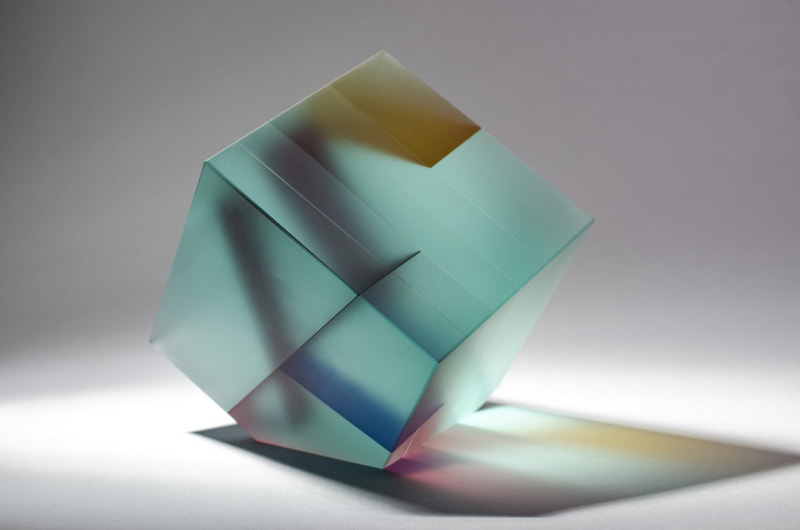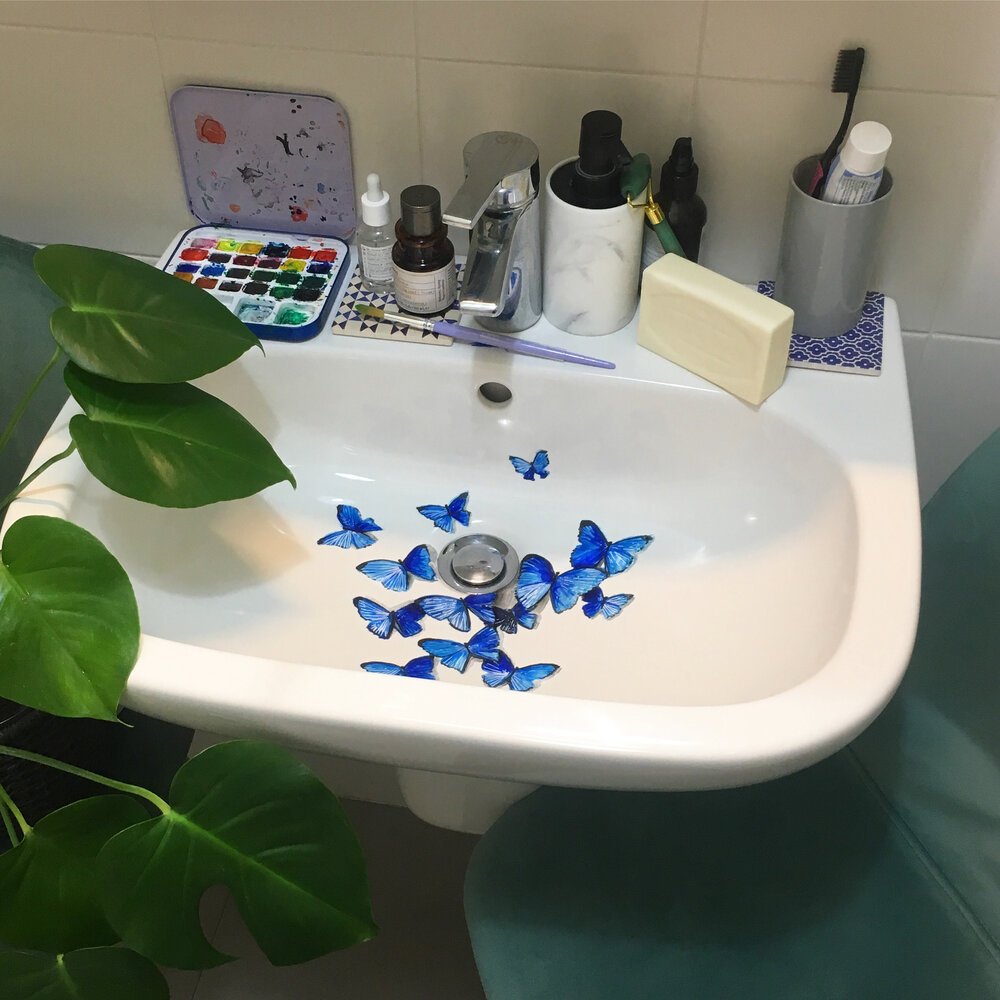Argentine artist Alejandro Herrera Guiñazú grew up playing in the studio of his father, a renowned artist and his first teacher Daniel Herrera. Later, trying to find his own way in arts, he studied “casting glass” and “cold working” techniques on the workshops of American sculptures.
Alejandro’s art is contemporary in appearance but inspired by ancient traditions of Maya, the five elements, and Quechua rituals like one of ayahuasca. Trying to stay connected to nature from where materials and inspiration of his art originate, he studies practices of ancient civilizations and searches for a simpler and more harmonic way of living.
Creations of Fire and Ice

Encriptado 
Intervencion 6 
Fragmento 

Meteorito 
Saturno 
Luzvioleta
Q & A with Alejandro Herrera Guiñazú
Culture Pledge: Can you tell us more about your tools and casting methods?
Alejandro Herrera Guiñazú: Lost wax cold casting is a very ancient technique. It consists in making a wax model, then creating a fire-resistant blank that handles extreme temperatures of 1000C. Wax inside it melts and gets replaced with liquid glass at 900C.
Cold working is a technique of carving and polishing a block of glass. The difference from chiseling stone is that the tools are refrigerated in water so that glass doesn’t break because of brusque changes of temperature. That’s why it’s called “cold working”.
My favorite techniques change from time to time. And the moment I’m fascinated by cold working most of all, but there’s times when I prefer to work with fire. Normally that happens in winter (laughs).
CP: Do you track innovations in your field? Are there any techniques you don’t practice at the moment but would like to implement in future?
AHG: I would absolutely love taking a course with the Italians that practice cold working in a unique way. They create textures in the glass.
This year I have created a new series of sculptures in glass and starting to work on big format, sculptures as tall as a man.
CP: What materials do you work with? Is it the material you use that dictates the form or vice versa?
AHG: I work with a large variety of materials but at the first place for me is glass and then – metal and stone. I love working with glass because it gives me opportunity to transmit color and light. Glass as any material used by a sculptor has its own language and takes you to the shapes that it brings inside its essence. Not that an artist can’t manipulate it as he would prefer. But one may let the material guide him, help him to create what was initially only an idea or a sketch. When I work with stone, I let it dictate me the form.

CP: What is more important: form or idea?
AHG: The idea and its shape arrive almost at the same time. But generally my work is much more important than just a shape. It reflects my soul in the determined moments of life and that is what I try to express in my sculptures.
CP: Are you normally happy about your final result?
AHG: We, artists, are never happy with a final result! (laughs) Moreover, it frequently happens to me that the piece I love the least finds its buyers the quickest (laughs again).
CP: Which one is your favorite among your own works? What does it symbolize?
AHG: I don’t really identify myself with one particular piece of art. I would love people to remember me for work I’ve done during the full length of my career as an artist, I would love them appreciate it when the body I inhabit won’t be the part of this world anymore. At that moment they will be able to apprehend my work as a whole.
CP: Where do you find inspiration recently?
AHG: At this moment of my life and career I try to grow spiritually and express the messages of what I have learnt in this process in each of my works. Light, air, universe and love serve as a source of inspiration for me. But I also travel to the darkest corners in my dreams. I’m very interested in alchemy, physical and spiritual, I’m attracted by flight – of body and soul.
Pre-Columbian cultures of America interest me the most. Indigenous deified nature and found saint spirits in it. They attributed spirits to plants. I find it in harmony with my own vision.
The message I try to transmit is veiled but visible for those who dare to see out of the box and dream on the same frequency.
CP: What artist of the present or past times would you distinguish and who has influenced you or served you as an example?
AHG: One of the artists I admire is Salvador Dali. He was a complex creator, who had luxury of speculating different art languages as painting, sculpture, gravure.
Surrealism, cubism and geometric designs are among my favorites.
Different Scenarios
CP: Was there a moment in your life when you decided to be an artist?
AHG: Such a moment doesn’t really exist. I was born in a family of artists and grew up playing in workshops. I think it was 2000 when I felt curiosity about sculpture for the first time. And 2010 was a year when I started my professional career as an artist.
CP: Who were your teachers?
AHG: I chose my teachers myself, how my father had taught me. There was a specific place – The Corning Museum of Glass in New York. I visited in 2010 and from there I started learning and had some important revelations for my career.
Loretta Yang, Milon Townsend, Daniel Cleyman, Martin Rosol, Vladimir Klein, Giyon Lee were my teachers. They instructed me on different techniques among which cold working and casting.
CP: What influence did your father have on your choices and creative vision? How do you feel when people link you to your famous dad?
AHG: My father is a great artist and celebrated in the artistic circles of Argentina. But I never meant to make a career similar to his. He never looked forward to be renowned. He had a more commercial focus: it brings more money but people don’t get to know your art.
In my case the art is more important for itself. Inspiration and message it carries. Income is secondary for me.
Despite that, my father influenced me a lot in an indirect form. He taught me the job of glass-artist, and it left its trace – as I mentioned, glass is my favorite material. And the artistic ambience I grew up in gave me opportunity to see all the different forms and techniques and choose my own.
CP: What is your relationship with your father today, as father and son and as of two artists?
AHG: My father Daniel Herrera and I are on very good terms. I don’t see him often, he lives in Chile. He’s a very complex artist, his specialty is lost wax bronze sculpture method. He loves realism. And recently he has been finding great inspiration particularly in horses, though mythology stays one of his favorite subjects.
CP: And how things have been for your father, are there common strategies and struggles across the generations?
AHG: My father doesn’t dedicate his life to arts anymore. He’s busy constructing his house nowadays.
We never really followed similar scenarios. We are very different.

CP: Tell me about your workshop. What’s your daily routine? What keeps you motivated during the day?
AHG: I start my workday early, at 8am I’m already in my workshop. I might be occupied by different tasks like sketching, writing, chiseling, sweeping the floor – there’s always something to do there. Music and my garden raise my spirits during my workday.
CP: Your wife Ivana is also an artist. Who dedicated himself to arts first? Do you work in tandem? What’s your role in it, what’s hers? What are advantages and disadvantages of working together when you’re a couple?
AHG: I work with my wife Ivanna. She joined the workshop of my father when we got married. We work together on stained-glassand “vitrofusion”. She also gives classes of both. And now she’s interested in participating in my sculpture projects.
The advantage of working with your partner is that we both have a chance to grow together, as professionals and individuals, supporting each other and boosting each other’s confidence. We might have different visions and that’s an advantage too. The masculine and the feminine when united give light.
I haven’t learnt the disadvantages yet. It’s important to respect each other’s space. With respect and comprehension work flows.
Paragliding for Art
CP: What are the difficulties of your career?
AHG: The hardest is the commercial. Money doesn’t come regularly but that bills do.
CP: Did you ever have doubts about your chosen career? How do you overcome crisis?
AHG: I never had doubts about my career. My crisis is normally connected with money. Work of an artist is not an economical subject, nevertheless, financial side is important. I resolve it giving classes or flying paragliding tandems with tourists.
CP: Is it possible to earn your living only from arts in Argentina?
AHG: Impossible. And our job is to make it change. Educating people, teaching them how essential the arts is in life of everyone.
CP: How do you raise funds to produce his work?
AHG: I teach workshop about crafts that I conduct together with my wife, workshops on stained-glass artwork and vitrofusion. These classes give us opportunity to carry on with our art and keep working on sculpture.
CP: How and where do you sell your work?
AHG: Normally I sell my sculptures through art galleries and through my site, ahgesculturas.com.
CP: How does online presence help you?
AHG: Тоday it’s the most important, I use Instagram and my site for promotion of my work.
CP: What is missing or what would help you to progress?
AHG: Most of all artists in Argentina lack distribution. Myself, I would love to have my own gallery that would represent me on the international level. In Europe or USA.
CP: How do you see your future of an artist?
AHG: I never look into future. I always try to live in present. Enjoy the moment. But to answer your question – I would like to keep working and know it’ll let me live peacefully.











